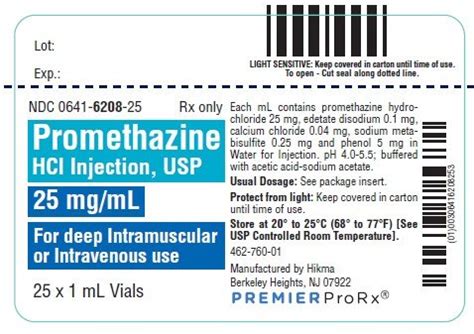Intro
Discover key facts about Promethazine, a potent antihistamine, including its uses, side effects, and interactions, to understand its role in treating allergies, nausea, and anxiety, while exploring its pharmacology and medical applications.
Promethazine is a medication that has been widely used for various purposes, including as an antihistamine, antiemetic, and sedative. Despite its widespread use, there are many aspects of promethazine that are not well understood by the general public. In this article, we will delve into the world of promethazine, exploring its history, uses, side effects, and other important facts.
The history of promethazine dates back to the 1940s, when it was first synthesized by a team of scientists at the French pharmaceutical company Rhône-Poulenc. Initially, the drug was marketed as an antihistamine, used to treat allergic reactions such as hay fever and itching. Over time, however, its uses have expanded to include the treatment of nausea and vomiting, as well as a sedative for patients undergoing surgery or other medical procedures. Today, promethazine is available in a variety of forms, including oral tablets, suppositories, and injectable solutions.
One of the most interesting aspects of promethazine is its unique mechanism of action. Unlike other antihistamines, which work by blocking the action of histamine at specific receptors in the body, promethazine works by blocking the action of histamine at multiple receptors. This allows it to produce a range of effects, from relieving itching and reducing inflammation to inducing sedation and preventing nausea. Additionally, promethazine has been shown to have anti-inflammatory properties, making it a useful treatment for conditions such as allergic rhinitis and asthma.
What is Promethazine Used For?

Benefits of Promethazine
The benefits of promethazine are numerous. For one, it is a highly effective treatment for allergic reactions, able to quickly relieve symptoms such as itching and inflammation. Additionally, promethazine is a useful treatment for nausea and vomiting, making it a popular choice for patients undergoing chemotherapy or other treatments that can cause these side effects. Promethazine is also a sedative, making it a useful treatment for patients who are having trouble sleeping or who need to relax before a medical procedure.How Does Promethazine Work?

Side Effects of Promethazine
While promethazine is generally a safe and effective medication, it can cause a range of side effects. These may include drowsiness, dizziness, and dry mouth, as well as more serious side effects such as confusion, hallucinations, and difficulty breathing. In rare cases, promethazine may also cause a condition known as neuroleptic malignant syndrome, which can be life-threatening if not treated promptly. It is essential to follow the instructions of a healthcare provider when taking promethazine and to report any side effects immediately.Precautions and Interactions

Overdose and Addiction
Promethazine can be habit-forming, and patients who take it for extended periods may experience withdrawal symptoms when they stop. Additionally, promethazine can cause an overdose if taken in excessive quantities, which can be life-threatening. Symptoms of an overdose may include confusion, hallucinations, and difficulty breathing, and patients who experience these symptoms should seek medical attention immediately.Alternatives to Promethazine

Conclusion and Future Directions
In conclusion, promethazine is a highly effective medication that has been used for a variety of purposes, including the treatment of allergic reactions, nausea and vomiting, and as a sedative. While it can cause side effects and interact with other medications, promethazine remains a popular choice for patients and healthcare providers alike. As research continues to uncover the benefits and risks of promethazine, it is likely that this medication will remain an essential tool in the treatment of a range of medical conditions.What is promethazine used for?
+Promethazine is used for a variety of purposes, including the treatment of allergic reactions, nausea and vomiting, and as a sedative.
How does promethazine work?
+Promethazine works by blocking the action of histamine at multiple receptors in the body, relieving symptoms such as itching, inflammation, and nausea.
What are the side effects of promethazine?
+Promethazine can cause a range of side effects, including drowsiness, dizziness, and dry mouth, as well as more serious side effects such as confusion, hallucinations, and difficulty breathing.
Can promethazine be addictive?
+Yes, promethazine can be habit-forming, and patients who take it for extended periods may experience withdrawal symptoms when they stop.
What are the alternatives to promethazine?
+Alternatives to promethazine include other antihistamines, such as diphenhydramine or chlorpheniramine, or antiemetics, such as ondansetron or metoclopramide.
We hope that this article has provided you with a comprehensive understanding of promethazine, its uses, benefits, and risks. If you have any further questions or would like to share your experiences with promethazine, please don't hesitate to comment below. Additionally, if you found this article informative, please share it with others who may benefit from this information. By working together, we can promote a better understanding of medications like promethazine and improve the health and well-being of individuals around the world.
